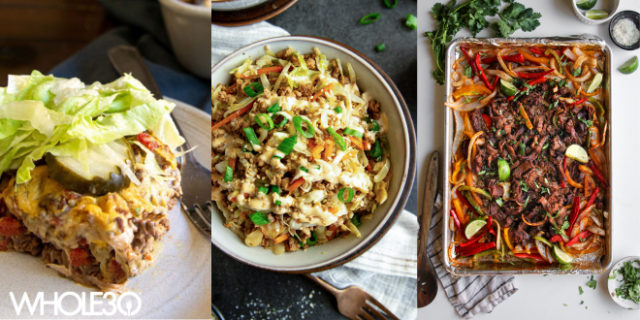Part 2 in our 2-part series on taming your Sugar Dragon Cravings. Urges. Irresistible pulls towards the sweet stuff, the carb-y stuff, the comfort stuff. This is collectively referred to as your “Sugar Dragon” in the Whole30 text; that fire-breathing beast clinging to your back, roaring loudly in your ear, demanding its next fix. We say the only way to slay the Sugar Dragon is to starve it, which is why the Whole30 rules are so strict. No added sugar, not even the natural stuff. No artificial sweeteners designed to fool your brain. No Paleo-fied pancakes, cookies, or ice cream, because your Sugar Dragon is just as happy with almond-flour brownies as the real deal. Starve your Dragon, and come out on the other end with a tame little gecko, feeling in control of the food you eat for the first time in a long time. We call that “food freedom.” After your Whole30, we teach you to ride your own bike*, making decisions about food and treats for yourself in the real world.. But while our system works incredibly well to help you turn what you learned during the program into life-long, healthy habits, inevitably, we all stumble. At some point, thanks to a vacation, holiday, special event, stressful situation, or maybe just because it’s Friday, you’ll wake your Sugar Dragon. You’ll start feeding him again, and like a Gremlin after midnight, he’ll grow faster and stronger than you feel prepared to handle. One day, you may just find yourself right back where you started, feeling out of control with your food choices, a slave to the cravings. *Refer to Chapter 20 in It Starts With Food In the first part of this two-part series, we talked about the one key principle to keep your Sugar Dragon at bay, and how to achieve this easier-said-than-done mantra. In today’s Part 2, we’re going to talk about identifying your Sugar Dragon triggers, because awareness is the key to keeping him docile in the first place. (And yes, after we talk about identifying your triggers, we’ll give you a plan of attack to combat them when they pop up.)
Trigger One: Specific Foods
This is an obvious one, and yet many of us overlook the reality that indulging in some sweet treats are no big deal, while others make us feel like we need more sugar NOW. Oh, and by the way, the stuff that brings your Sugar Dragon back to life isn’t always sweet. First, pay attention every time you eat a sweet treat, carb-y confection, or any less-healthy fare you’d personally label “comfort food.” (This is the third trick we outlined in Part 1: eat carefully and with awareness. Don’t allow yourself to get distracted while you’re indulging, don’t eat too fast, and actually taste what you’re eating.) Then, when you’re done, continue to pay attention. Do you feel satisfied and happy, or do you want more… of anything you can get your hands on? Did eating this decrease or increase your cravings? Do you feel more in control after your careful indulgence, or less? You’ll find that some foods will bring about a satisfied, in-control, craving-satisfied response; while others make you want to eat All the Things. Maybe you can have a few pieces of semi-dark chocolate and be perfectly happy, but a cupcake or cookie sends you off on a sugar-bender. These individual triggers are different for everyone, but we’d bet if you thought about it for a few minutes, you could identify at least one or two that are surefire Sugar Dragon agitators for you. And if you start paying attention when you indulge, you’ll be in a far better position to identify the culprits right then and there. Finally, understand that your trigger may not be a sweet treat! For me (Whole30 co-founder Melissa Urban), chips and salsa are both verifiable food-with-no-brakes and bring her Sugar Dragon roaring to life; there’s just something about the combination of salt and crunch that make me crave something sweet like it’s my full-time job. The lesson? Pay attention every time you eat off-plan, eat with awareness, and if you have any hope of taming your Dragon for good, be brutally honest when you notice a reaction to a particular food.
Trigger Two: Emotional Connections
Sometimes it’s not the food itself, but the association you have with the food that rouses your Dragon. For example, bread is something I almost never eat—I basically consider it off-limits, because 99% of the time, it’s just not good enough to be worth it. But on those occasions when it’s fresh-baked, still warm, and served with a honey butter, I’ll indulge… and immediate start craving everything in sight. What’s going on here? The idea of eating bread basically opens the less-healthy-food floodgates on an emotional and psychological level. I think to myself, well if I’m eating bread, it must be a free-for-all! It’s a touch of the “what the hell” effect: after giving into a little temptation, we say, “What the hell, my clean eating is already ruined, might as well go all in (with the cheese, and the wine, and the cake…).” It’s not the bread itself, it’s the idea of eating bread. You may have certain foods, people, places, or things that create an emotional connection in your head between that particular trigger and major cravings. I heard a story about a woman who, as a child, was always taken out for ice cream by her dad after her parents fought. To this day, she craves sweets any time she hears a couple arguing. I have another friend who goes on major sugar binges when her husband travels for work—she says it’s like if there is no one to see her, it doesn’t count. The next time your Sugar Dragon comes screaming to life, stop and ask yourself, what’s the trigger here? Is it what I ate, my emotional state, the person I’m with, where I am, the time of day? What commonality can I find about this experience with other instances of cravings and overindulgence?
Trigger Three: Stress
The third and final trigger is one we’ve discussed many times here and on the Whole9 site: stress drives cravings. It’s biological, it’s physiological, and no matter how many Whole30’s you do, you cannot escape it. (See my 2014 20-minutes Paleo(f)x video on Stress and Cravings for the details. If you’ve been struggling with cravings despite eating “clean,” I promise, it’s worth a watch.) This isn’t hard to identify. Do you have physical stress? That could mean under-eating; not sleeping enough; over-training (or under-recovering); dealing with an injury, illness, or ailment; or toxic exposures. Do you have psychological stress? Are you dealing with anger, fear, worry, anxiety, depression, guilt, shame, abandonment, rejection, betrayal, jealousy, social isolation, abuse, divorce, death, financial worries, career stress, relationship problems, self-worth or self-esteem issues? All of these inputs create physiological changes in the body that make us crave sugar. Which means even if we’re eating squeaky clean, stress and emotional connections can bring our Sugar Dragon to life faster than we can say, “This sucks.”
Sugar Dragon 101
These trigger-identifying tips and action items (coupled with the conscious eating we discussed in Part 1) should be enough to put your Sugar Dragon on notice, especially with practice. But remember, you can’t expect to fully decades worth of habits, associations, and cravings with the Whole30 alone. It requires dedication, patience, practice, and grace in life after your Whole30 too—and perhaps a return to the structure and rules of the Whole30 program from time to time. To paraphrase from The Whole30: Inevitably, at some point sooner or later, you will fall back into old habits. In truth, we’d be shocked if you didn’t… (but) do not panic. Everything will be okay, because we have a plan for this too. When your Sugar Dragon is roaring… come back to the Whole30. Get back to the place where everything is humming and your self-confidence is high and you’re back in the driver’s seat. Then, ride your own bike again, following the tips we’ve given you in this 2-part series. Wash, rinse, repeat as often as needed and you’ll find your Sugar Dragon grows weaker and weaker, roars for a far shorter period of time, and is progressively that much easier to tame. And remember, in this event (which is a lifelong healthy pursuit, not a short-term competition), progress of any sort is winning.
 Melissa Urban is a Certified Sports Nutritionist, and the author of the New York Times bestselling book It Starts With Food and The Whole30: The 30-Day Guide to Total Health and Food Freedom. She has been featured in the Wall Street Journal, Details, Outside, Redbook, and Shape as the co-founder of Whole9 and the Whole30 program. Melissa lives in Salt Lake City, UT. Header photo credit: Erin K. Handley. Bio photo credit: Taylor Gage, She Thrives Blog
Melissa Urban is a Certified Sports Nutritionist, and the author of the New York Times bestselling book It Starts With Food and The Whole30: The 30-Day Guide to Total Health and Food Freedom. She has been featured in the Wall Street Journal, Details, Outside, Redbook, and Shape as the co-founder of Whole9 and the Whole30 program. Melissa lives in Salt Lake City, UT. Header photo credit: Erin K. Handley. Bio photo credit: Taylor Gage, She Thrives Blog

















